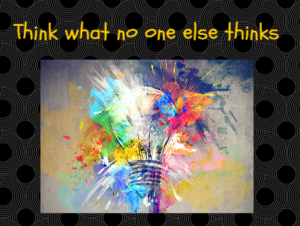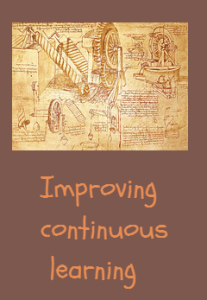Does design thinking what no one else thinks mean you must be 100% original? Not in our minds. Do you ever wonder what makes those wacky, creative types tick?

How is it that some people seem to come up with all kinds of interesting, original work while the rest of us trudge along in our daily routines?
Check out our thoughts on building innovation.
Don’t believe you are creative? Creativity is often defined as the ability to connect ideas that are seemingly unconnectable. Connecting ideas are how new ideas originate … it is the basis for creativity.
Related: Secrets to Understanding the Genie in the Creativity Bottle
Contrary to what most people believe, creativity is not limited to the gifted ones of the population. It can be taught, nurtured, and enhanced.
Let’s examine these interesting questions.
Creative people are different because they operate a little differently.
Can you share an example of a way you operate a little different to help your creativity? We love to hear about it. Please share in the comments section below.
Here is the how:
What no one else thinks … build on others
One of the misunderstandings around creativity is that you have to be utterly original to do it. The truth is all creative people stand on the shoulders of those who came before.
Writers learn to write by reading; painting students are sent to museums to copy the masters, while great chefs learn the already tested basics of cooking to create some new dish.
Innovation stands on a platform that already exists. Yes, inspiration is involved, those flashes of insight, the ah…ha moments. You start with something that already exists and takes it to another level.
So relax. Let go of thinking you have to do something original. Take the pressure off. Celebrate that there is all this help available.
Related post: How You Are Destroying your Creativity and Imagination

Question everything
Want to think what nobody has ever thought? Start by questioning all assumptions.
There comes a moment in time where everyone agrees with everybody about pretty much everything. For any sized organization that is focused on creating a culture of relentless innovation, hardened dogma is a change obstacle they must overcome.
And that starts best with questioning everything, assumptions included.
Design thinking … pay attention to patterns
Treat models as part of the problem. Recognizing a new pattern is very useful, but be careful not to become part of it.
Observe with all senses
Truly creative people have developed their ability to see and to use all of their senses, which can get dull over time. Take time to “sharpen the blade” and take everything in.
Incubate ideas
Let your ideas “incubate” by taking a break from them. For example, when I’m working on a big business project, one of the best things I can do to take a break from it is listening to music or watch TV for a while.
It shifts my brain into another place and helps me be more innovative and creative.

Continuous learning
Both creativity and innovation are based on knowledge. Therefore, you need to continually expand your knowledge base. Read things you don’t usually read as often as you can.
Design thinking empathy … defer judgment
Your perceptions may limit your reasoning. Be careful about how you perceive things. In other words, suspend judgment.
Widen your experiences
Experience as much as you can. Exposure puts more ideas into your subconscious. Actively seek out new and very different experiences to broaden your experience portfolio.
Reset problem definition
Redefine the problem completely. One of the lines I’ve been sharing for the past few decades is: “Your problem is not the problem; there is another issue. When you define the real problem, you can solve it and move on.”
After all, if you had correctly set the real problem, you would have solved it long ago because all problems have solutions.
Look for what is not easily seen
Look where others aren’t seeking to see what others aren’t seeing.
Design thinking steps … be curious
Ask lots of questions, but suspend first judgment on the answers. Try and connect the dots as you go.
Take challenges and risks
Be a risk taker and continually push your boundaries. Don’t worry about mistakes. Accept failures. Fearlessness is necessary for creative work, because of the possibility of rejection.
Anything new requires a bit of change, and most of us don’t care for change that much.
What no one else thinks … immerse yourself
Put yourself deep into the topic at hand. Focus with no multiplexing.
Be able to overlook rules
Rules, to the creative person, are indeed made to be broken. They are created for us by other people, generally to control a process; the creative person needs the freedom to work.
Ask “what if…”
Seeing new possibilities is a little risky because it means that something will change and some action will have to be taken. Curiosity is probably the single most important trait of creative people.
Push the boundaries of mistakes
A photographer doesn’t just take one shot, and a composer doesn’t just write down a fully realized symphony. Creation is a long process, involving lots of boo-boos along the way. A lot goes in the trash.
Collaborate
The hermit artist, alone in his garret, is a romantic notion but not always an accurate one. Comedians, musicians, painters, chefs all get a little better by sharing with others in their fields.
Try new paths
Stepping off the beaten path may be scary, but creative people do it. Children do this very well but are eventually trained to follow the crowd.
Experiment often
Combining things that don’t usually go together can result in brilliance or a giant mess. Trial and error are necessary to the creative process.
Key takeaways
As you can see, many of these skills / suggestions do not take much time and effort to make a difference. Just a lot of practice. Start from small and transform your skills.
Creating creative skills is a process that takes time, patience, and exercise.

If you are looking for additional resources in innovation, one of my favorite experts is Stephen Shapiro. You’ll find lots of good stories and examples to learn in his blog.
Need some help in improving the creativity of you and your staff? Creative ideas to help the differentiation with your toughest competitors?
Call today for a FREE consultation or a FREE quote. Learn about some options for creativity workshops to get noticeable results.
Call Mike at 607-725-8240.
All you get is what you bring to the fight. And that struggle gets better every day you learn and apply new creative ideas.
When things are not what you want them to be, what’s most important is your next step. Call today.
Try. Learn. Improve. Repeat.
Are you devoting enough energy to improve your creativity, innovation, and ideas?
Do you have a lesson about making your creativity better you can share with this community? Have any questions or comments to add in the section below?
Digital Spark Marketing will stretch your thinking and your ability to adapt to change. We also provide some fun and inspiration along the way. Call us for a free quote today. You will be amazed at how reasonable we will be.
More reading on creativity and innovation from Digital Spark Marketing’s Library:
Learn How to Think What No One Else Thinks
Generating Ideas by Convergent Thinking
Amazon and Managing Innovation … the Jeff Bezos Vision
The Secrets to Building an Innovative Culture
Mike Schoultz is a digital marketing and customer service expert. With 48 years of business experience, he consults on and writes about topics to help improve the performance of small business. Find him on G+, Facebook, Twitter, Digital Spark Marketing, and LinkedIn.
